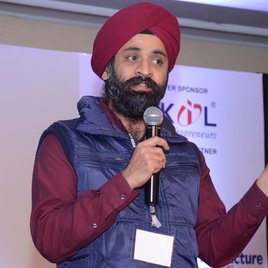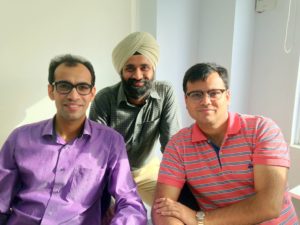
 Zenatix has developed an innovative product called WattMan. It’s an IoT based Building Management System (BMS) tailor-made for retail chains and banking set-ups that helps them in reducing their electricity consumption by up to 30 per cent, says Dr Amarjeet Singh, Chief Technology Officer, and Co-founder, Zenatix, in conversation with Priyanka Sharma of Elets News Network (ENN).
Zenatix has developed an innovative product called WattMan. It’s an IoT based Building Management System (BMS) tailor-made for retail chains and banking set-ups that helps them in reducing their electricity consumption by up to 30 per cent, says Dr Amarjeet Singh, Chief Technology Officer, and Co-founder, Zenatix, in conversation with Priyanka Sharma of Elets News Network (ENN).
Give us an overview of Zenatix.
Zenatix Solutions is a data-driven energy efficiency company that uses IoT and advanced machine learning based models to save up to 30 per cent energy for large commercial consumers of electricity like retail chains and banking set-ups. Zenatix is innovating in a market segment, using innovations in Internet of Things and machine learning. It functions in the operational energy efficiency segment wherein we retrofit our product, WattMan, to monitor and analyse data from existing non-connected electrical appliances for clients. Analysis of the collected data is then used to take actions helping in operational efficiency at several levels for the clients. Currently our clientele includes large retail chains and banking organisations and we are expanding to other customer segments such as large office buildings, hotels, hospitals and industrial units.

What energy-efficient model has Zenatix build?
Hardware products designed by Zenatix, together with innovations on the IoT stack (managing billions of data points) and analytics specific to the application vertical (one such vertical is energy and electrical asset management that we currently focus on) allow us to innovate such that a significant value add is delivered through customised solutions that are low on hardware and exploit advanced machine learning algorithms on the collected data.

 The key points that differentiate us from competition are:
The key points that differentiate us from competition are:
- Internally developed IoT stack – Our stack provides distinct advantage over other off-the-shelf solutions since it is built while keeping in mind specific use cases that the target market segment cares for.
- Robust hardware – Hardware is developed in-house and has been made robust over multiple iterations which mean the hardware can withstand challenges arising from fluctuating voltage, intermittent network connectivity and external factors such as noise or weather conditions.
Operational excellence – We have a strong team to deliver the installation of our solution across different geographies seamlessly.
Tell us more about IoT based WattMan?
Energy efficiency is a critical element for sustainability and a lot of work is being done in this domain. Energy efficiency, delivered in different ways, is the least expensive source of power compared to any other source of energy. However, so far, much of the focus in energy efficiency has been on retrofits (build and deploy more energy efficient light bulbs, air conditioners, etc.). Often overlooked is the power of data driven energy efficiency – no matter whether you have an efficient or inefficient infrastructure, if you are not operating it well, you will bleed on energy.
In this respect, Zenatix has developed an innovative product called WattMan. It’s an IoT based Building Management System (BMS) tailor-made for retail chains and banking set-ups (essentially, anyone who has large number of geographically distributed infrastructure) that helps them in reducing their electricity consumption by up to 30 per cent. Given the distributed nature of retail/ banking set-ups (multiple outlets/ branches spread across the country), having control over the electricity spends and providing the right customer experience at the same time is a big challenge. WattMan addresses these challenges in an automated manner by delivering intelligent controls together with predictive and preventive maintenance. All this is powered by advanced machine learning algorithms. It employs our proprietary firmware for performing automatic sensing and control. Collected data is used to develop machine learning driven models deciding optimal operational settings based on external factors like weather and footfall, thus allowing sophisticated control.
 Kindly share your thoughts on involvement of startups for NITI Aayog’s National Energy Policy?
Kindly share your thoughts on involvement of startups for NITI Aayog’s National Energy Policy?
The Government think tank, NITI Aayog, came up with a draft National Energy Policy (NEP) in June 2017, revealing the electrical distribution to commercial pressure, technology interventions such as use of advanced sensing technologies, data analytics and a clear focus on energy efficiency. Yet, it falls short of integrating the innovative startup ecosystem. Few suggestions that can be included in the NEP can be
- Innovation around making existing appliances (specifically ACs since they are one of the biggest guzzlers and are becoming mainstream) smart, in addition to focusing on increased energy efficiency of the appliances that will come in the future.
- An active promotion of collaboration between energy efficiency related institutions (such as EESL and BEE) and new age startups
- Certain problems like voltage fluctuations, poor internet connectivity unreliable grid power, unaffordability at times are contextual to the Indian scenario and the policy should consider these as well. Accordingly solutions for smart grid, energy efficiency etc. should rather be sourced from local innovative startups that understand and address these challenges rather than procurement from developed economies.
- It may be useful to expand the scope of such coordinated effort to related schemes such as “Make in India” or “Startup India” to encourage further innovation in this context.
What kind of case studies do you undertake?
For a typical retail customer with 100s or 1000s of locations, we start with a paid pilot for 6-12 months at a small number of locations (5-10). Since the business model does not involve any capital expenditure as the customer pays an annual subscription fee, this is a low enough investment which is easy to get through. Thereafter, we develop a baseline consumption pattern (whereby we are just collecting data and not taking any control action) at the pilot locations and compare that baseline with WattMan starts taking control of their assets. Energy savings and other benefits are then proven to build a business case which is then internally taken up by a customer to scale from pilot locations to 100s of locations.
We have seen success with such a model across various verticals in retail chains – supermarkets, telecom stores, apparel stores, QSR and in BFSI – ATMs, bank branches, insurance offices.
EESL, a public sector enterprise also works on a similar model though to achieve energy savings they largely perform retrofits (e.g replacing normal lights with LEDs or inefficient ACs with inverter ACs). These retrofits can be typically expensive – smaller for LEDs and much larger for ACs. We deliver energy savings by optimising the operations – even if you have an energy efficient inverter AC, if it is running all night it is still wastage. Since our solution is complementary to EESL offering, we are in discussions with them for a joint offering whereby in addition to retrofits they can additionally offer operational efficiency through our integrated solution. While these discussions are in early stages, such collaborations are key to addressing the long term energy demands for India.
 What new solutions are you planning to launch soon?
What new solutions are you planning to launch soon?
The key strength that we have built is our end to end IoT stack – from in-house design hardware to our own IoT stack and thereafter the analytics engine which can derive actionable insights from millions of collected data points.
Our current solution offering – WattMan, exploits this strength to deliver energy efficiency to retail chains and banks. While delivering such a solution, we always keep the focus on improving the whole stack in a way it can be easily extended for other IoT use cases.
We are already receiving requests for solutions outside of our retail and BFSI where this stack fits in nicely. However, we are still in the evaluation stages. We will most likely experiment first with some solutions that are natural extensions of WattMan and will serve our existing customer base. In due course of time, we will experiment with other solutions and take up those where we believe a meaningful scale (annual revenue of 30-50 million USD) can be built.
Current objective is to keep focus on WattMan – scale it to 5000 locations in next 9 months and 20,000 in subsequent 1 year; and in the process keep improving the end to end IoT stack which will eventually be the big differentiator for us in monetising IoT where several others have failed.
Be a part of Elets Collaborative Initiatives. Join Us for Upcoming Events and explore business opportunities. Like us on Facebook , connect with us on LinkedIn and follow us on Twitter, Instagram.











